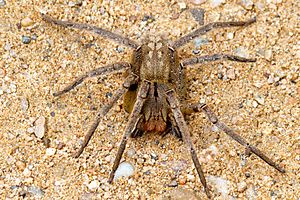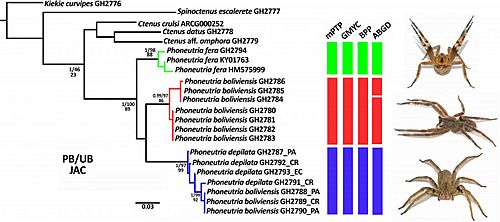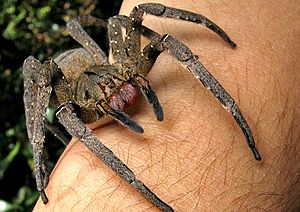Brazilian wandering spider facts for kids
Quick facts for kids Brazilian wandering spider |
|
|---|---|
 |
|
| Phoneutria nigriventer | |
| Scientific classification |
|
| Kingdom: | Animalia |
| Phylum: | Arthropoda |
| Subphylum: | Chelicerata |
| Class: | Arachnida |
| Order: | Araneae |
| Infraorder: | Araneomorphae |
| Family: | Ctenidae |
| Genus: | Phoneutria Perty, 1833 |
| Type species | |
| Phoneutria fera Perty, 1833
|
|
| Species | |
|
See text |
|
| Diversity | |
| 9 species | |
Phoneutria is a group of spiders known for wandering. They belong to the family Ctenidae. These spiders are mostly found in northern South America. One species also lives in Central America.
People often call them Brazilian wandering spiders. Other common names include armed spiders (armadeiras in Brazilian Portuguese) and banana spiders. This last name is also used for other types of spiders.
Contents
What Do Phoneutria Spiders Look Like?
Phoneutria spiders can have a leg span from about 13 to 18 centimeters (5 to 7 inches). Their body length can be from 1.7 to 4.8 centimeters (0.7 to 1.9 inches).
You can tell these spiders apart by a few things. They have thick, fine hairs on their legs. They also have a dark stripe on their front palps (small leg-like parts near their mouth). A thin black line often runs along their back.
Their leg undersides have strong dark markings with lighter joints. The underside of their belly might have rows of black dots or look reddish.
How They Act When Scared
When these spiders feel threatened, they show a special defensive pose. They lift their body up high. The first two pairs of legs go up, showing off their black and light striped undersides. The spider also sways from side to side. This makes them look bigger and more scary.
Where Does the Name Phoneutria Come From?
The name Phoneutria was first used by Maximilian Perty in 1833. The name comes from a Greek word, phoneutria. This word means "murderess."
Types of Phoneutria Spiders
As of 2021, the World Spider Catalog lists nine accepted species in this group. These species are found in different parts of Central and South America. For example, Phoneutria boliviensis lives in Central and South America. Phoneutria nigriventer is found in Brazil, Uruguay, Paraguay, and Argentina.
How Phoneutria Spiders Live
These spiders are called "wandering spiders" because they don't build webs to catch food. Instead, they walk around the jungle floor at night looking for prey. During the day, they hide in places like termite mounds or under logs and rocks. They also like to hide in banana plants, which is why they are sometimes called "banana spiders."
One species, P. nigriventer, often hides in dark, damp spots near or inside human homes. It is very important to be careful around these spiders. You should never try to touch them. Their venom can make people very sick.
P. nigriventer spiders usually mate during the dry season, from April to June. They are often seen more during this time.
Where Phoneutria Spiders Live
Phoneutria spiders live in forests from Costa Rica all the way south through South America. They are found east of the Andes mountains. This includes countries like Colombia, Venezuela, Ecuador, Peru, Brazil, and Argentina.
Some species, like P. fera, are only found in the Amazon region. Others, like P. boliviensis, also live in Central America.
Why They Are Called Banana Spiders
These spiders got the name "banana spider" because people sometimes find them in shipments of bananas. There have been reports of these spiders appearing in banana boxes in different countries. This is why people need to be careful when handling bananas.
Are Phoneutria Spiders Dangerous?
Phoneutria spiders can be dangerous to humans. Their venom is toxic, meaning it's like a poison to people. Their bites can make people very sick. Because they wander and don't stay in one place, they might hide in houses, clothes, or shoes. If someone accidentally disturbs them, they might bite.
Spider mouthparts are made for biting small prey. They are not really made for biting large animals like humans. However, their bites can still cause serious problems.
Symptoms after a bite can include a fast heartbeat, high blood pressure, dizziness, fever, and sweating. People might also have blurry vision, feel sick to their stomach, throw up, or have trouble breathing. These symptoms can start within 10 to 20 minutes. It is very important to get medical help right away if someone is bitten.
Related pages
- Phoneutria fera, a type of spider also known as the Brazilian wandering spider. It lives in South America.
See also
 In Spanish: Araña bananera para niños
In Spanish: Araña bananera para niños




